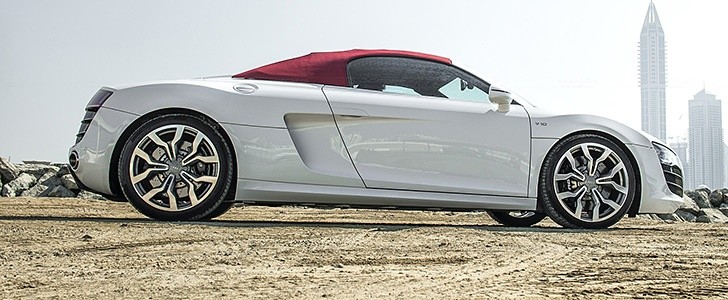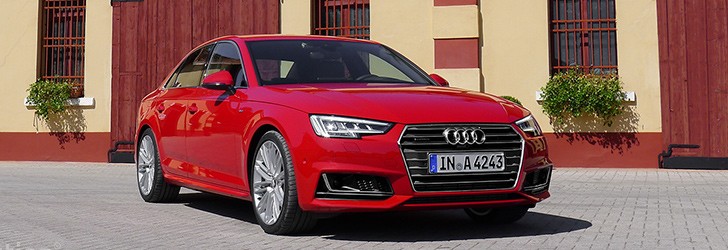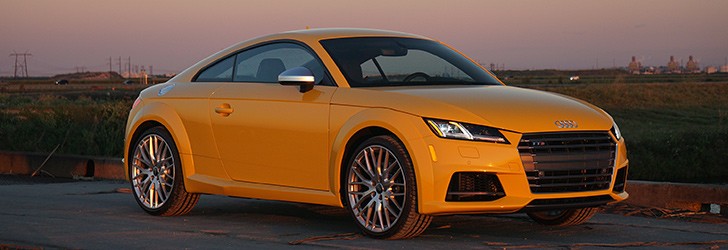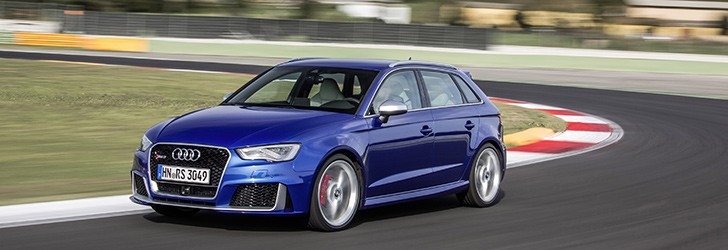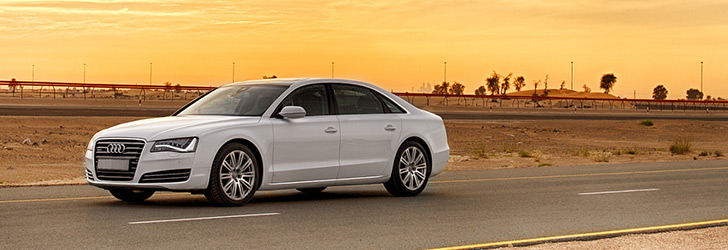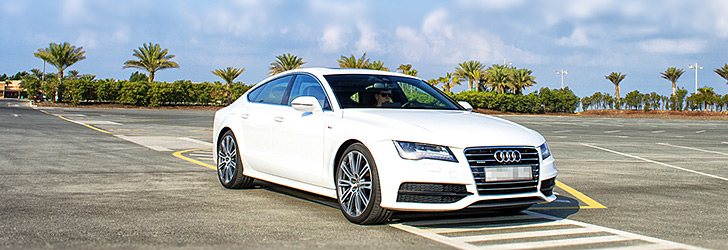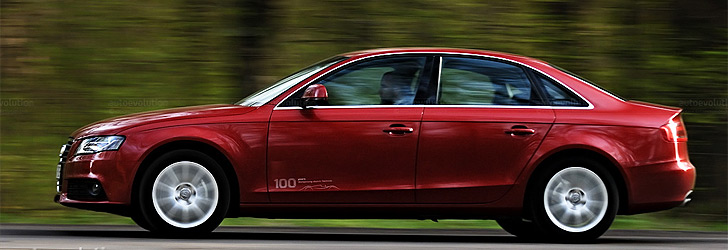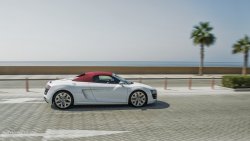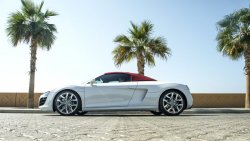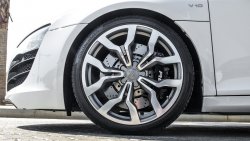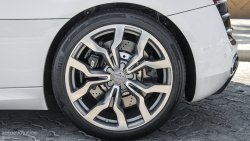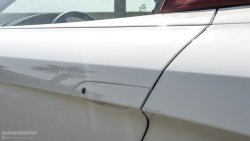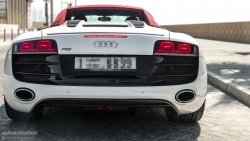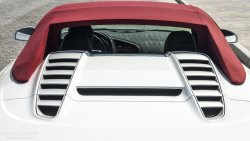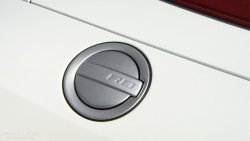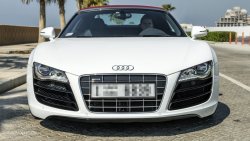AUDI R8 V10 Spyder Review
OUR TEST CAR: AUDI R8 V10 Spyder 2012
The Audi R8 V10 is a supercar that can be used everyday, a rare feat in its league. This asset comes thanks to multiple characteristics of the car and we’ll start with the more obvious ones.
Getting in and out of the car spares you of the usual embarrassment associated with this kind of machines. The generous door openings, the well-balanced seats and the decent ride height each bring a contribution here.
And there’s more to discuss about the last two aforementioned aspects. The seats don’t just offer easy access, but there also pleasant to use, even during long trips. In the Spyder model we drove, they use a special infrared-reflecting leather that allows them to reduce temperature by up to 20 degrees Celsius (68 degrees Fahrenheit).
As for the adaptive suspension, which uses magnetorheological dampers, the standard mode keeps you isolated from small and moderate road imperfections.
The pleasing visibility adds some piece of mind and here is where the car starts to show a special side, one that reveals a finesse which may not be visible at first glance.
The car can be rather docile if you want it to, despite the explosive performance, which is there both on paper and in the real world.
Even though it has a V10 engine at its center, the Audi R8 doesn’t heat up as most supercars do. The only exception to this is the luggage compartment up front. This area, which, by the way, is limited to 100 liters (3.53 cu. ft.), gets pretty hot during long drives and you’d have no problem using it to bring your coffee up to serving temperature.
The interior space is decent for a compact supercar, but the driver has to push the seat backwards considerably in order to be able to use the footrest. The passenger could also use some extra room for stretching his legs during long trips.
The aforementioned finesse is even showed when the roof is folded. You can play with the roof while on the move, but we preferred to spare a few moments in order to watch the ballet-like movements. And when you want to have the canvas above your head, you’ll thank Audi for using three layers of fabric. The thermal insulation still can’t match that of a folding metal top, but the acoustic one is good.
The final touch is brought by the navigation system. You really wouldn’t expect a car that’s a symbol of German engineering to offer a navigation voice that’s almost sensual in the way it pronounces various destinations, but the R8 does just that. Our guest editor, Sir May B Bach aims to find the woman whom the voice belongs to, but this is another story.
The R8 made its parents extremely happy when it was an infant, as his first words were: “ASF”, “quattro” and “FSI”. We’ll start with the first, which stands for Audi Space Frame and describes the company’s aluminum vehicle fabrication technology.
Body and Chassis
The Audi R8’s body is initially built in three separate sections, the front end, the central compartment and the rear end. These make up the substructure of the car, while the pillars, the roof, side walls, cover panels and doors are added after the first three are joined - The elements of the ASF skeleton are bonded using manual weld seams, while the body panels are fixed using self-piercing rivets and automatically-applied self-tapping screws.
The vehicle’s body in white uses three types of aluminum: 75 percent of this is represented by extruded aluminum sections, vacuum-cast nodes account for 8 percent, while the remaining 17 percent goes to the aluminum panels of the car. The last use alloys that cure under heat, so the R8’s body achieves its final hardness at the end of the painting process, when the vehicle is drying in the oven. The R8 also uses other lightweight materials, such as magnesium, which is found in the frame that supports the engine.
The Spyder shares about 70 percent of its parts with the coupe. The engineers reinforced the bulkhead and the transmission tunnel in order to compensate for the loss of rigidity brought by the use of a canvas roof. Other measures used with the same aim include the strengthening of the side sills, as well as of the pillars.
The Coupe comes with plastic plates under its floor to create a flat underbody, but on the Spyder these are built from aluminum and doubled by a crossbeam in order to increase rigidity.
Even with all the aforementioned reinforcements, the body in white of the Spyder tips the scales at just 6 kg (13.23 lbs) higher compared to that of the coupe. The impressively small difference doesn’t only come from the lack of the roof, but also thanks to the extensive use of carbon fiber. The material is used for the large top cover, as well as for the doors of the vehicle.
The Audi R8 also turns to special plastic as part of its diet - the engine compartment cover and the rear spoiler are made from fiber-reinforced plastic, while thermoplastics are found in the aprons.
Of course, the R8 Spyder can’t escape the weight and rigidity penalty in the end. Compared to the coupe, it loses 20 percent in stiffness and gains 100 kg (220.5 lbs). Nevertheless, the balance of the car has been kept intact. The axle load has moved just 1 percent towards the rear compared to the coupe, with the Spyder showing a ratio of 43:57.
Powertrain
It’s time to move on to the engine bay now. Our Audi R8 test car had a 5,204 cc (317.6 cu.in.) V10 naturally-aspirated powerplant and so did the Lamborghini Gallardo we drove in the past. Yes, the two share the engine, but each offers a distinct output and sound.
The standard R8 V10 delivers 525 hp at 8,000 rpm and 530 Nm (391 lb-ft) of torque at 6,500 rpm, while a Gallardo LP 560-4 offers 560 hp at 8,000 rpm and a peak torque of 540 Nm (398 lb-ft). The two sets of output values come derive from the fact that there are a few mechanical differences between the two units. Each comes with its dedicated intake and exhaust systems and, of course, with specific ECU mapping.
We have to explain that the V10 powerplant was first seen on the Lamborghini Gallardo, in the previous 5.0-liter incarnation, but this was based on the Audi 4.2-liter V8, which had been developed by Cosworth.
Even in the more civilized form found on our test car, the V10 engine still delivers 100.9 hp per liter, a value that’s doubled by others which are just as enjoyable, such as the 8,700 rpm maximum rev limit.
The 90-degree configuration of the ten-cylinder unit reduces its height and thus lower the car’s center of gravity.
When the engine undergone the aforementioned transformation from 5.0 to 5.2-liters, it received multiple changes, such as being gifted with dry sump lubrication. This further reduces the height of the engine, as there’s no need for a large oil pan under the powerplant.
There lubrication system uses an external tank and oil pump, which takes the oil separately from the crankshaft, chain box and the cylinder heads, using a pair of coolers to lower the temperature. On the skidpad, the R8 V10 can deliver a lateral acceleration of about 1.2 g, but the system is able to maintain perfect lubrication up to a value of 2 g.
The unit also received FSI, Audi’s version of direct fuel injection. Fuel is injected in the combustion chamber at a pressure of up to 120 bar. The injectors are placed on the side of the cylinder head - the fuel mixture acts like a vortex, cooling the cylinder walls and thus reducing knocking sensitivity. This enables the engine to use a high compression ratio of 12.5:1, increasing both performance and efficiency.
One of the ways in which the engine manages to produce its divine soundtracks comes from its ignition intervals. Each pair of opposing connecting rods use a common crankpin, as the crankshaft features a common pin shaft configuration. Among others, this means that the unit alternately fires in 54 and 90 degree intervals, which dramatically impacts the way it sounds.
The engine’s flexibility is offered by the variable valve timing, as well as by the architecture of the intake manifold. This uses ECU-controlled tumble flaps to vary the airflow. For example, at low revs and load, the air is swirled, which results in a more even mixture in the cylinders and therefore superior combustion efficiency.
The Audi R8 also shares its optional robotized single-clutch manual six-speed transmission with the revamped Lamborghini Gallardo, while the only difference between the two implementations is the software. The designation of the gearbox is, of course, also distinct: Audi calls its version R-Tronic, while for the Italian model they named it e-gear.
The paddles on the steering wheel send an electric impulse to the transmission’s hydraulic system, which works at a pressure between 40 and 50 bars. The hydraulics activate the clutch and also take care of the changes themselves. At full blast, the system can deliver blistering 100 ms shifts.
Since the Audi R8 uses a mid-engined layout, the quattro permanent All-Wheel Drive system needed a dedicated layout. It all starts with the aforementioned gearbox, which is placed transversely behind the V10 powerplant.
There’s a shaft that goes through the engine to the center differential, a viscous coupling unit with electronic control. The standard setup is nothing like Audi’s usual 4WD one, sending 85 percent of the power to the rear. Here, we find a mechanical LSD that can lock up to 25 percent under power, with the value increasing to 40 percent during overrun. Should the front axle need more power, the system can offer it up to 30 percent.
Road Connection
The R8 is suspended on double forged aluminum wishbones at all corners, a motorsport-proven solution. Audi tops this with its magnetic ride adaptive suspension. This constantly monitors the road profile and driving style and adjusts the damping characteristics for each wheel.
For example, when the vehicle enters a bend, the damper of the outermost wheel is hardened, in an effort to reduce body roll. The system also allows the driver to choose between two settings, normal and sport.
Inside the shock absorbers, we find synthetic hydrocarbon oil that features microscopic magnetic particles. The particles can react to electrical current being applied to a coil - they can form a 90 degree angle to the direction in which the oil flows through the channels in the piston and thus stop the flow. The process offers significantly faster response times compared to hydraulic-only adaptive suspension system - a few milliseconds are enough for the particles to rearrange.
The V10 models use a specific 10-spoke Y-shaped design for their forged alloy wheels, with the standard setup including a tire size of 235/35 up front and 295/30 at the back.
Stopping Power
The standard deceleration hardware on V10 models is comprised of vented and perforated steel brakes, such as the ones on our test car. The front wheels use 365 mm (14.37-inch) rotors with eight-piston calipers, while at the back we have 356 mm (14.02-inch) discs with six-piston grabbers.
As an optional feature, you can choose carbon ceramic brakes featuring 380 mm (14.96-inch) rotors that work with six-piston calipers up front, as well as 360 mm (14.17-inch) rotors and four-piston grabbers at the rear.
The steel discs feature a wave profile for the outer area, saving 2 kg (4.4 lbs) compared to a traditional design. As for the carbon ceramics, these offer a 12 kg 924.6 lbs) weight reduction versus the aforementioned steel brakes.
Both parts of this vehicle's designation require it to offer a comprehensive list of features. First of all, the Audi badge means that the cabin has to be as luxurious as ever. In addition to that, the association between the "R8" name and the practical supercar status means that the vehicle must cater to far more needs than just go-fast ones.
From the Audi R8 Spyder's standard equipment list we'll mention the magnetic adaptive suspension, the full-LED headlights, the exterior mirrors with power-folding, heating and LED signals, the parking system plus with a rear-view camera, as well as the front, side (head & thorax) and knee airbags.
We'll also mention the V10-dedicated 19-inch Y-design wheels, the Bang & Olufsen sound system, the navigation system plus, the Nappa leather 10-way power-adjustable heated sport seats.
The optional extras also feature some tempting features, especially the technical ones: the ceramic brakes and paddle shift gearbox. The 2013 model replaces the robotized manual R-Tronic with a double-clutch S-Tronic, trading shift feel during sporty driving for greater refinement.
There's also a carbon fiber treatment for the exterior, as well as for the cabin. The first includes the lower front bumper, side blades, mirrors and diffuser. As for the interior, this receives the wonder material for the door entry sills and trimming. In addition to that, Audi offers an engine compartment carbon fiber treatment.
Apart from that, you can opt for a perforated leather multifunction steering wheel, illuminated door sills and a white background for the instruments - this is extremely visible, be it day or night. We have to mention that the R8's steering wheel is also used in the Lamborghini Aventador, albeit with some modifications.
What’s more, you can choose the MMI navigation plus that uses a 6.5-inch display and comes with two SD card slots and satellite radio. This also includes a music interface with iPod integration, but the the latter can also be ordered separately.
The list of optional features also allows you to choose between multiple designs for the 19-inch rims of the vehicle.
Audi has also introduced an R8 personalization program called Exclusive, which debuted in Europe and was subsequently expanded to North America. This includes nine new exterior shades for the body and side blades. As for the cabin, this receives 17 new options, which means that you can customize the various parts of the interior as you please.
The Audi R8's supercar nature means that it hasn’t been tested by any safety organization. Nevertheless, the vehicle has quite a few aces up its sleeve, both in terms of active and passive safety. Some of the characteristics that brought the R8 extra points for the "Open road" chapter also increase its score here. We have to start with the Audi Space Frame all-aluminum body structure, which brings an impressive level of rigidity.
To counteract the loss in rigidity brought by the lack of the roof, the Spyder comes with reinforced areas. The floor, sills and pillars of the car have been strengthened compared to those of the coupe.
The Spyder features two rollover protection elements. We are talking about a pair of spring-loaded aluminum parts placed in the bulkhead of the car. These are controlled using magnetic switches, which work independently and can be raised in just 0.2 of a second.
The protection elements are activated by the deployment of a belt tensioner or an airbag. Speaking of airbags, the Spyder offers two-stage ones for the frontal impact protection, passenger and driver knee airbags, as well as seat backrest-mounted head and thorax side airbags. However, not even the coupe models offer side curtain airbags. As for the rear impact, the R8 relies on Audi's integral head restraint system to minimize the risk of whiplash injuries.
The quattro all-wheel drive also plays an important role for this chapter. Unlike that in most Audis, this is seriously rear-biased, but it can send up to 30 percent of the power to the front wheels when this is necessary.
We must also mention that the R8 was the first production car in the world to feature all-LED headlights and you'll enjoy the benefits of this everytime the sun goes down.
“Good things come to those who wait” - this could be the motto behind the R8. Audi has been planning to offer a mid-engined go-fast vehicle for quite a while. The carmaker did its homework meticulously both on the road and on the track and it came up with a brilliant proposal.
The company’s positioning within the VW Group meant that Audi couldn’t simply go out there and release the most superlative-filled model in the segment - The automaker had to find a balance. Not only did Ingolstadt manage to stay away from making too many compromises, but the market positioning it chose for the vehicle turned it into a dream come true: a practical supercar.
The Audi R8 is a superstar who hasn't lost his mind due to the fame and this is its best part of it. If you want a supercar that you can use everyday, you can’t go wrong with this one.
In V10 configuration it offers stunning performance, with serious, linear firepower and engaging handling. The vehicle also grants you easy access to this. What’s more, it has plenty of feel, so you don’t have to push it hard in order to enjoy it.
Alas, the family-induced limitations do catch up with the R8 in the end. The worst part of Audi’s supercar is the fact that it isn’t as emotional as its rivals from Italy. The driving experience is thrilling, but it lacks that final lunatic edge.
You get the same feeling inside the car, where everything works perfect, but there are a bit too many connections with civilian Audi models. The list of downsides also includes the limited storage capacity. This, however, is a common issue in its class.
The Spyder version is worth paying attention to, since it features a well-developed roof and doesn’t dilute the dynamic experience.
A V10 R-Tronic Spyder model like the one we drove starts at $171,800, or €156,400, depending on which side of the pond you’re on. Thus, despite sharing most of the hardware with the Lamborghini Gallardo, the German supercar is considerably more affordable.
The Italian does win a very important battle when it comes to supercar territory, the character one. It obviously also earns more image points. However, the Audi R8 proves superior in terms of usability and makes the the Lambo feel outdated in terms of features.
In the end the two can’t actually be compared. After all, the VW Group wouldn’t have allowed them to coexist in this forms had they targeted the same audience.
The R8 V10’s price also places it in the same financial league as the Porsche 911 Turbo S. The aforementioned conclusion also applies here - the two are extremely different, so it’s very difficult to place them in opposite corners of the same ring. The Audi R8 V10 can’t match the performance of the Porsche, but it’s far more spectacular and much more fun to drive everyday.
Audi has recently introduced a facelift for the R8. This brings limited upgrades, with one exception: the replacement of the R-Tronic with an S-Tronic double-clutch unit. The R8 has been on the market since 2006 and the fact that Audi chose to only bring it minor changes shows that it feels about the car in the same way we do - extremely pleased.
Getting in and out of the car spares you of the usual embarrassment associated with this kind of machines. The generous door openings, the well-balanced seats and the decent ride height each bring a contribution here.
And there’s more to discuss about the last two aforementioned aspects. The seats don’t just offer easy access, but there also pleasant to use, even during long trips. In the Spyder model we drove, they use a special infrared-reflecting leather that allows them to reduce temperature by up to 20 degrees Celsius (68 degrees Fahrenheit).
As for the adaptive suspension, which uses magnetorheological dampers, the standard mode keeps you isolated from small and moderate road imperfections.
The pleasing visibility adds some piece of mind and here is where the car starts to show a special side, one that reveals a finesse which may not be visible at first glance.
The car can be rather docile if you want it to, despite the explosive performance, which is there both on paper and in the real world.
Even though it has a V10 engine at its center, the Audi R8 doesn’t heat up as most supercars do. The only exception to this is the luggage compartment up front. This area, which, by the way, is limited to 100 liters (3.53 cu. ft.), gets pretty hot during long drives and you’d have no problem using it to bring your coffee up to serving temperature.
The interior space is decent for a compact supercar, but the driver has to push the seat backwards considerably in order to be able to use the footrest. The passenger could also use some extra room for stretching his legs during long trips.
The aforementioned finesse is even showed when the roof is folded. You can play with the roof while on the move, but we preferred to spare a few moments in order to watch the ballet-like movements. And when you want to have the canvas above your head, you’ll thank Audi for using three layers of fabric. The thermal insulation still can’t match that of a folding metal top, but the acoustic one is good.
The final touch is brought by the navigation system. You really wouldn’t expect a car that’s a symbol of German engineering to offer a navigation voice that’s almost sensual in the way it pronounces various destinations, but the R8 does just that. Our guest editor, Sir May B Bach aims to find the woman whom the voice belongs to, but this is another story.
The R8 made its parents extremely happy when it was an infant, as his first words were: “ASF”, “quattro” and “FSI”. We’ll start with the first, which stands for Audi Space Frame and describes the company’s aluminum vehicle fabrication technology.
Body and Chassis
The Audi R8’s body is initially built in three separate sections, the front end, the central compartment and the rear end. These make up the substructure of the car, while the pillars, the roof, side walls, cover panels and doors are added after the first three are joined - The elements of the ASF skeleton are bonded using manual weld seams, while the body panels are fixed using self-piercing rivets and automatically-applied self-tapping screws.
The vehicle’s body in white uses three types of aluminum: 75 percent of this is represented by extruded aluminum sections, vacuum-cast nodes account for 8 percent, while the remaining 17 percent goes to the aluminum panels of the car. The last use alloys that cure under heat, so the R8’s body achieves its final hardness at the end of the painting process, when the vehicle is drying in the oven. The R8 also uses other lightweight materials, such as magnesium, which is found in the frame that supports the engine.
The Spyder shares about 70 percent of its parts with the coupe. The engineers reinforced the bulkhead and the transmission tunnel in order to compensate for the loss of rigidity brought by the use of a canvas roof. Other measures used with the same aim include the strengthening of the side sills, as well as of the pillars.
The Coupe comes with plastic plates under its floor to create a flat underbody, but on the Spyder these are built from aluminum and doubled by a crossbeam in order to increase rigidity.
Even with all the aforementioned reinforcements, the body in white of the Spyder tips the scales at just 6 kg (13.23 lbs) higher compared to that of the coupe. The impressively small difference doesn’t only come from the lack of the roof, but also thanks to the extensive use of carbon fiber. The material is used for the large top cover, as well as for the doors of the vehicle.
The Audi R8 also turns to special plastic as part of its diet - the engine compartment cover and the rear spoiler are made from fiber-reinforced plastic, while thermoplastics are found in the aprons.
Of course, the R8 Spyder can’t escape the weight and rigidity penalty in the end. Compared to the coupe, it loses 20 percent in stiffness and gains 100 kg (220.5 lbs). Nevertheless, the balance of the car has been kept intact. The axle load has moved just 1 percent towards the rear compared to the coupe, with the Spyder showing a ratio of 43:57.
Powertrain
It’s time to move on to the engine bay now. Our Audi R8 test car had a 5,204 cc (317.6 cu.in.) V10 naturally-aspirated powerplant and so did the Lamborghini Gallardo we drove in the past. Yes, the two share the engine, but each offers a distinct output and sound.
The standard R8 V10 delivers 525 hp at 8,000 rpm and 530 Nm (391 lb-ft) of torque at 6,500 rpm, while a Gallardo LP 560-4 offers 560 hp at 8,000 rpm and a peak torque of 540 Nm (398 lb-ft). The two sets of output values come derive from the fact that there are a few mechanical differences between the two units. Each comes with its dedicated intake and exhaust systems and, of course, with specific ECU mapping.
We have to explain that the V10 powerplant was first seen on the Lamborghini Gallardo, in the previous 5.0-liter incarnation, but this was based on the Audi 4.2-liter V8, which had been developed by Cosworth.
Even in the more civilized form found on our test car, the V10 engine still delivers 100.9 hp per liter, a value that’s doubled by others which are just as enjoyable, such as the 8,700 rpm maximum rev limit.
The 90-degree configuration of the ten-cylinder unit reduces its height and thus lower the car’s center of gravity.
When the engine undergone the aforementioned transformation from 5.0 to 5.2-liters, it received multiple changes, such as being gifted with dry sump lubrication. This further reduces the height of the engine, as there’s no need for a large oil pan under the powerplant.
There lubrication system uses an external tank and oil pump, which takes the oil separately from the crankshaft, chain box and the cylinder heads, using a pair of coolers to lower the temperature. On the skidpad, the R8 V10 can deliver a lateral acceleration of about 1.2 g, but the system is able to maintain perfect lubrication up to a value of 2 g.
The unit also received FSI, Audi’s version of direct fuel injection. Fuel is injected in the combustion chamber at a pressure of up to 120 bar. The injectors are placed on the side of the cylinder head - the fuel mixture acts like a vortex, cooling the cylinder walls and thus reducing knocking sensitivity. This enables the engine to use a high compression ratio of 12.5:1, increasing both performance and efficiency.
One of the ways in which the engine manages to produce its divine soundtracks comes from its ignition intervals. Each pair of opposing connecting rods use a common crankpin, as the crankshaft features a common pin shaft configuration. Among others, this means that the unit alternately fires in 54 and 90 degree intervals, which dramatically impacts the way it sounds.
The engine’s flexibility is offered by the variable valve timing, as well as by the architecture of the intake manifold. This uses ECU-controlled tumble flaps to vary the airflow. For example, at low revs and load, the air is swirled, which results in a more even mixture in the cylinders and therefore superior combustion efficiency.
The Audi R8 also shares its optional robotized single-clutch manual six-speed transmission with the revamped Lamborghini Gallardo, while the only difference between the two implementations is the software. The designation of the gearbox is, of course, also distinct: Audi calls its version R-Tronic, while for the Italian model they named it e-gear.
The paddles on the steering wheel send an electric impulse to the transmission’s hydraulic system, which works at a pressure between 40 and 50 bars. The hydraulics activate the clutch and also take care of the changes themselves. At full blast, the system can deliver blistering 100 ms shifts.
Since the Audi R8 uses a mid-engined layout, the quattro permanent All-Wheel Drive system needed a dedicated layout. It all starts with the aforementioned gearbox, which is placed transversely behind the V10 powerplant.
There’s a shaft that goes through the engine to the center differential, a viscous coupling unit with electronic control. The standard setup is nothing like Audi’s usual 4WD one, sending 85 percent of the power to the rear. Here, we find a mechanical LSD that can lock up to 25 percent under power, with the value increasing to 40 percent during overrun. Should the front axle need more power, the system can offer it up to 30 percent.
Road Connection
The R8 is suspended on double forged aluminum wishbones at all corners, a motorsport-proven solution. Audi tops this with its magnetic ride adaptive suspension. This constantly monitors the road profile and driving style and adjusts the damping characteristics for each wheel.
For example, when the vehicle enters a bend, the damper of the outermost wheel is hardened, in an effort to reduce body roll. The system also allows the driver to choose between two settings, normal and sport.
Inside the shock absorbers, we find synthetic hydrocarbon oil that features microscopic magnetic particles. The particles can react to electrical current being applied to a coil - they can form a 90 degree angle to the direction in which the oil flows through the channels in the piston and thus stop the flow. The process offers significantly faster response times compared to hydraulic-only adaptive suspension system - a few milliseconds are enough for the particles to rearrange.
The V10 models use a specific 10-spoke Y-shaped design for their forged alloy wheels, with the standard setup including a tire size of 235/35 up front and 295/30 at the back.
Stopping Power
The standard deceleration hardware on V10 models is comprised of vented and perforated steel brakes, such as the ones on our test car. The front wheels use 365 mm (14.37-inch) rotors with eight-piston calipers, while at the back we have 356 mm (14.02-inch) discs with six-piston grabbers.
As an optional feature, you can choose carbon ceramic brakes featuring 380 mm (14.96-inch) rotors that work with six-piston calipers up front, as well as 360 mm (14.17-inch) rotors and four-piston grabbers at the rear.
The steel discs feature a wave profile for the outer area, saving 2 kg (4.4 lbs) compared to a traditional design. As for the carbon ceramics, these offer a 12 kg 924.6 lbs) weight reduction versus the aforementioned steel brakes.
Both parts of this vehicle's designation require it to offer a comprehensive list of features. First of all, the Audi badge means that the cabin has to be as luxurious as ever. In addition to that, the association between the "R8" name and the practical supercar status means that the vehicle must cater to far more needs than just go-fast ones.
From the Audi R8 Spyder's standard equipment list we'll mention the magnetic adaptive suspension, the full-LED headlights, the exterior mirrors with power-folding, heating and LED signals, the parking system plus with a rear-view camera, as well as the front, side (head & thorax) and knee airbags.
We'll also mention the V10-dedicated 19-inch Y-design wheels, the Bang & Olufsen sound system, the navigation system plus, the Nappa leather 10-way power-adjustable heated sport seats.
The optional extras also feature some tempting features, especially the technical ones: the ceramic brakes and paddle shift gearbox. The 2013 model replaces the robotized manual R-Tronic with a double-clutch S-Tronic, trading shift feel during sporty driving for greater refinement.
There's also a carbon fiber treatment for the exterior, as well as for the cabin. The first includes the lower front bumper, side blades, mirrors and diffuser. As for the interior, this receives the wonder material for the door entry sills and trimming. In addition to that, Audi offers an engine compartment carbon fiber treatment.
Apart from that, you can opt for a perforated leather multifunction steering wheel, illuminated door sills and a white background for the instruments - this is extremely visible, be it day or night. We have to mention that the R8's steering wheel is also used in the Lamborghini Aventador, albeit with some modifications.
What’s more, you can choose the MMI navigation plus that uses a 6.5-inch display and comes with two SD card slots and satellite radio. This also includes a music interface with iPod integration, but the the latter can also be ordered separately.
The list of optional features also allows you to choose between multiple designs for the 19-inch rims of the vehicle.
Audi has also introduced an R8 personalization program called Exclusive, which debuted in Europe and was subsequently expanded to North America. This includes nine new exterior shades for the body and side blades. As for the cabin, this receives 17 new options, which means that you can customize the various parts of the interior as you please.
The Audi R8's supercar nature means that it hasn’t been tested by any safety organization. Nevertheless, the vehicle has quite a few aces up its sleeve, both in terms of active and passive safety. Some of the characteristics that brought the R8 extra points for the "Open road" chapter also increase its score here. We have to start with the Audi Space Frame all-aluminum body structure, which brings an impressive level of rigidity.
To counteract the loss in rigidity brought by the lack of the roof, the Spyder comes with reinforced areas. The floor, sills and pillars of the car have been strengthened compared to those of the coupe.
The Spyder features two rollover protection elements. We are talking about a pair of spring-loaded aluminum parts placed in the bulkhead of the car. These are controlled using magnetic switches, which work independently and can be raised in just 0.2 of a second.
The protection elements are activated by the deployment of a belt tensioner or an airbag. Speaking of airbags, the Spyder offers two-stage ones for the frontal impact protection, passenger and driver knee airbags, as well as seat backrest-mounted head and thorax side airbags. However, not even the coupe models offer side curtain airbags. As for the rear impact, the R8 relies on Audi's integral head restraint system to minimize the risk of whiplash injuries.
The quattro all-wheel drive also plays an important role for this chapter. Unlike that in most Audis, this is seriously rear-biased, but it can send up to 30 percent of the power to the front wheels when this is necessary.
We must also mention that the R8 was the first production car in the world to feature all-LED headlights and you'll enjoy the benefits of this everytime the sun goes down.
“Good things come to those who wait” - this could be the motto behind the R8. Audi has been planning to offer a mid-engined go-fast vehicle for quite a while. The carmaker did its homework meticulously both on the road and on the track and it came up with a brilliant proposal.
The company’s positioning within the VW Group meant that Audi couldn’t simply go out there and release the most superlative-filled model in the segment - The automaker had to find a balance. Not only did Ingolstadt manage to stay away from making too many compromises, but the market positioning it chose for the vehicle turned it into a dream come true: a practical supercar.
The Audi R8 is a superstar who hasn't lost his mind due to the fame and this is its best part of it. If you want a supercar that you can use everyday, you can’t go wrong with this one.
In V10 configuration it offers stunning performance, with serious, linear firepower and engaging handling. The vehicle also grants you easy access to this. What’s more, it has plenty of feel, so you don’t have to push it hard in order to enjoy it.
Alas, the family-induced limitations do catch up with the R8 in the end. The worst part of Audi’s supercar is the fact that it isn’t as emotional as its rivals from Italy. The driving experience is thrilling, but it lacks that final lunatic edge.
You get the same feeling inside the car, where everything works perfect, but there are a bit too many connections with civilian Audi models. The list of downsides also includes the limited storage capacity. This, however, is a common issue in its class.
The Spyder version is worth paying attention to, since it features a well-developed roof and doesn’t dilute the dynamic experience.
A V10 R-Tronic Spyder model like the one we drove starts at $171,800, or €156,400, depending on which side of the pond you’re on. Thus, despite sharing most of the hardware with the Lamborghini Gallardo, the German supercar is considerably more affordable.
The Italian does win a very important battle when it comes to supercar territory, the character one. It obviously also earns more image points. However, the Audi R8 proves superior in terms of usability and makes the the Lambo feel outdated in terms of features.
In the end the two can’t actually be compared. After all, the VW Group wouldn’t have allowed them to coexist in this forms had they targeted the same audience.
The R8 V10’s price also places it in the same financial league as the Porsche 911 Turbo S. The aforementioned conclusion also applies here - the two are extremely different, so it’s very difficult to place them in opposite corners of the same ring. The Audi R8 V10 can’t match the performance of the Porsche, but it’s far more spectacular and much more fun to drive everyday.
Audi has recently introduced a facelift for the R8. This brings limited upgrades, with one exception: the replacement of the R-Tronic with an S-Tronic double-clutch unit. The R8 has been on the market since 2006 and the fact that Audi chose to only bring it minor changes shows that it feels about the car in the same way we do - extremely pleased.
THE END
12
Our AUDI Testdrives:
Photo gallery (83)
